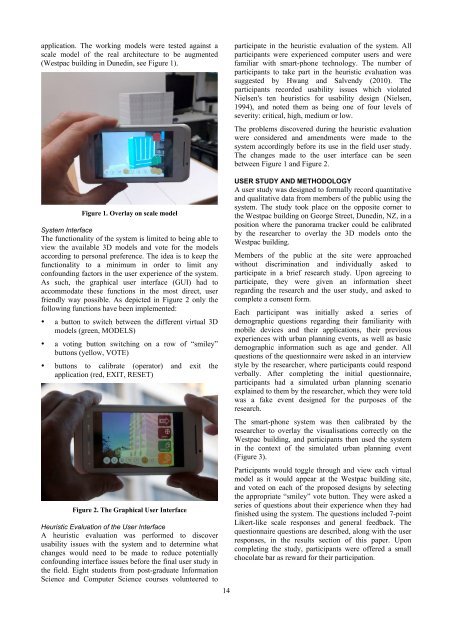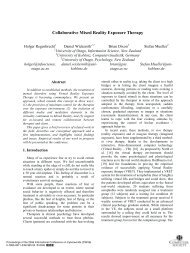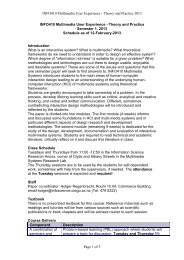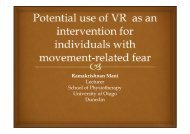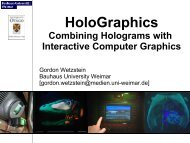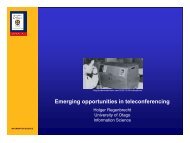Smart-phone augmented reality for public participation in urban ...
Smart-phone augmented reality for public participation in urban ...
Smart-phone augmented reality for public participation in urban ...
You also want an ePaper? Increase the reach of your titles
YUMPU automatically turns print PDFs into web optimized ePapers that Google loves.
application. The work<strong>in</strong>g models were tested aga<strong>in</strong>st a<br />
scale model of the real architecture to be <strong>augmented</strong><br />
(Westpac build<strong>in</strong>g <strong>in</strong> Duned<strong>in</strong>, see Figure 1).<br />
Figure 1. Overlay on scale model<br />
System Interface<br />
The functionality of the system is limited to be<strong>in</strong>g able to<br />
view the available 3D models and vote <strong>for</strong> the models<br />
accord<strong>in</strong>g to personal preference. The idea is to keep the<br />
functionality to a m<strong>in</strong>imum <strong>in</strong> order to limit any<br />
confound<strong>in</strong>g factors <strong>in</strong> the user experience of the system.<br />
As such, the graphical user <strong>in</strong>terface (GUI) had to<br />
accommodate these functions <strong>in</strong> the most direct, user<br />
friendly way possible. As depicted <strong>in</strong> Figure 2 only the<br />
follow<strong>in</strong>g functions have been implemented:<br />
• a button to switch between the different virtual 3D<br />
models (green, MODELS)<br />
• a vot<strong>in</strong>g button switch<strong>in</strong>g on a row of “smiley”<br />
buttons (yellow, VOTE)<br />
• buttons to calibrate (operator) and exit the<br />
application (red, EXIT, RESET)<br />
Figure 2. The Graphical User Interface<br />
Heuristic Evaluation of the User Interface<br />
A heuristic evaluation was per<strong>for</strong>med to discover<br />
usability issues with the system and to determ<strong>in</strong>e what<br />
changes would need to be made to reduce potentially<br />
confound<strong>in</strong>g <strong>in</strong>terface issues be<strong>for</strong>e the f<strong>in</strong>al user study <strong>in</strong><br />
the field. Eight students from post-graduate In<strong>for</strong>mation<br />
Science and Computer Science courses volunteered to<br />
14<br />
participate <strong>in</strong> the heuristic evaluation of the system. All<br />
participants were experienced computer users and were<br />
familiar with smart-<strong>phone</strong> technology. The number of<br />
participants to take part <strong>in</strong> the heuristic evaluation was<br />
suggested by Hwang and Salvendy (2010). The<br />
participants recorded usability issues which violated<br />
Nielsen's ten heuristics <strong>for</strong> usability design (Nielsen,<br />
1994), and noted them as be<strong>in</strong>g one of four levels of<br />
severity: critical, high, medium or low.<br />
The problems discovered dur<strong>in</strong>g the heuristic evaluation<br />
were considered and amendments were made to the<br />
system accord<strong>in</strong>gly be<strong>for</strong>e its use <strong>in</strong> the field user study.<br />
The changes made to the user <strong>in</strong>terface can be seen<br />
between Figure 1 and Figure 2.<br />
USER STUDY AND METHODOLOGY<br />
A user study was designed to <strong>for</strong>mally record quantitative<br />
and qualitative data from members of the <strong>public</strong> us<strong>in</strong>g the<br />
system. The study took place on the opposite corner to<br />
the Westpac build<strong>in</strong>g on George Street, Duned<strong>in</strong>, NZ, <strong>in</strong> a<br />
position where the panorama tracker could be calibrated<br />
by the researcher to overlay the 3D models onto the<br />
Westpac build<strong>in</strong>g.<br />
Members of the <strong>public</strong> at the site were approached<br />
without discrim<strong>in</strong>ation and <strong>in</strong>dividually asked to<br />
participate <strong>in</strong> a brief research study. Upon agree<strong>in</strong>g to<br />
participate, they were given an <strong>in</strong><strong>for</strong>mation sheet<br />
regard<strong>in</strong>g the research and the user study, and asked to<br />
complete a consent <strong>for</strong>m.<br />
Each participant was <strong>in</strong>itially asked a series of<br />
demographic questions regard<strong>in</strong>g their familiarity with<br />
mobile devices and their applications, their previous<br />
experiences with <strong>urban</strong> plann<strong>in</strong>g events, as well as basic<br />
demographic <strong>in</strong><strong>for</strong>mation such as age and gender. All<br />
questions of the questionnaire were asked <strong>in</strong> an <strong>in</strong>terview<br />
style by the researcher, where participants could respond<br />
verbally. After complet<strong>in</strong>g the <strong>in</strong>itial questionnaire,<br />
participants had a simulated <strong>urban</strong> plann<strong>in</strong>g scenario<br />
expla<strong>in</strong>ed to them by the researcher, which they were told<br />
was a fake event designed <strong>for</strong> the purposes of the<br />
research.<br />
The smart-<strong>phone</strong> system was then calibrated by the<br />
researcher to overlay the visualisations correctly on the<br />
Westpac build<strong>in</strong>g, and participants then used the system<br />
<strong>in</strong> the context of the simulated <strong>urban</strong> plann<strong>in</strong>g event<br />
(Figure 3).<br />
Participants would toggle through and view each virtual<br />
model as it would appear at the Westpac build<strong>in</strong>g site,<br />
and voted on each of the proposed designs by select<strong>in</strong>g<br />
the appropriate “smiley” vote button. They were asked a<br />
series of questions about their experience when they had<br />
f<strong>in</strong>ished us<strong>in</strong>g the system. The questions <strong>in</strong>cluded 7-po<strong>in</strong>t<br />
Likert-like scale responses and general feedback. The<br />
questionnaire questions are described, along with the user<br />
responses, <strong>in</strong> the results section of this paper. Upon<br />
complet<strong>in</strong>g the study, participants were offered a small<br />
chocolate bar as reward <strong>for</strong> their <strong>participation</strong>.


